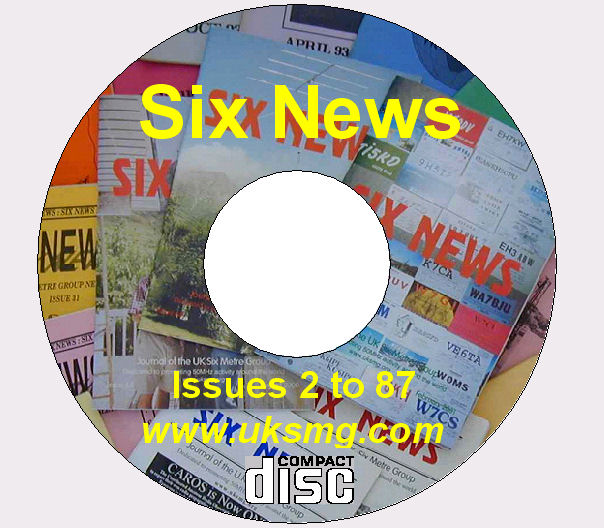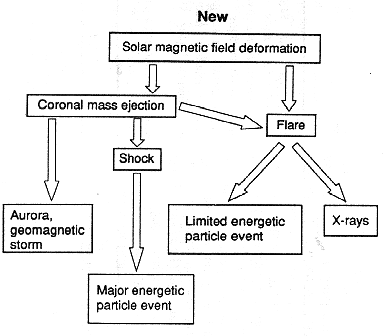

home > archive > propagation theory > the solar myth

Thanks to all of our authors since 1982!
|
the
solar myth |
|
|
Wrong, says Jack Gosling (Los Alamos National Laboratory), whose year-long efforts to spread a new gospel of solar-terrestrial lore culminated with the publication of his article "The solar flare myth" (J. geophys. Res 98, 18937-18949; 1993), and the success of a session he organised for a meeting in December 1993 entitled, innocently enough "The solar-terrestrial connection". The article and session conveyed a revolutionary message: solar flares do not cause magnetic storms and attendant auroral displays, nor do they cause most of the associated, hazardous fluxes of solar energetic particles; coronal mass ejection’s do.
Coronal mass ejection’s are rapid reconfigurations of coronal structures that involve the ejection into the solar wind of immense quantities (even by solar standards) of coronal material. Detectable only from space-borne coronographs - instruments that eclipse the Sun’s bright disk - they appear as gigantic loop-like bubbles subtending up to a quarter of the Sun’s circumference. The bubbles lift off into space, leaving behind only bright legs rooted to the sun. As coronal mass ejection’s are space-age latecomers to the solar-terrestrial scene (they were discovered in the early 1970s), space physicists are only now appreciating their central relevance to the field. So explained the session’s lead speaker, Steve Kahler (Air Force Phillips Laboratory), who traced the history of studies that established a clear, although far from perfect, correlation between flares and aurorae, or more commonly between flares and the magnetic storms that accompany aurorae. The reason that the misconception about flares is so entrenched in solar-terrestrial physics, he argued, is that correlation was mistaken for cause, a textbook case of the famous logical fallacy. Usually establishing correlation is the first step towards establishing cause. But in the case of flares and aurorae, both are side-effects of a common cause, coronal mass ejection’s (see Fig. 2).
On the other hand, not all flares are cause by coronal mass ejection’s, as flares occur much more frequently. Art Hundhausen (NCAR High Altitude Observatory) explained that flares may be cause by "magnetic reconnection", a process in which magnetic fields pointing in opposite directions annihilate each other and release energy in the form of X-rays and energetic particles. Because the solar surface is constantly in motion, like a boiling liquid, and because its rotation rate is not uniform in latitude or with depth, its embedded magnetic fields are constantly shifting, deforming and twisting on a hierarchy of scale sizes. As a result, oppositely directed magnetic fields are frequently brought together, triggering reconnection and consequent flares. Coronal mass ejection’s involve a specific form of large-scale magnetic field deformation. As a mass ejection rises off the surface, it draws out the oppositely directed magnetic fields in the legs of its loop-like form, which can then reconnect and cause a flare. Thus flares can be side-effects of coronal mass ejection’s as well as a common phenomenon elsewhere on the Sun. Don Reames (NASA Goddard Space Flight Center) corrected the misconception that flares produce large-scale expulsions of solar energetic particles. Although flares do impart energy to particles (possibly directly through reconnection or indirectly by generating instabilities and shock waves in the corona), the huge shock waves that fast coronal mass ejection’s push before them can energize particles on a much grander scale. Particles accelerated by these shocks can be distinguished from those associated with flares through measurements of composition and charge state. These show that flare-associated particles are limited to narrow cone angles, where as ejection-association particles can span cones covering half of interplanetary space. Jack Gosling adduced convincing evidence that coronal mass ejection’s cause all of the larger magnetic storms and accompanying aurorae. The properties of mass ejection’s responsible for storms are the strength and configuration of their magnetic fields, and their high speeds - not the energetic particles, contrary to most popular and some scientific accounts. The magnetic field in the quiet solar wind usually lies in the ecliptic plane. But the loop-like fields in mass ejection’s have strong, north-south components. As the Earth’s magnetic field points northward, any oncoming southward fields reconnect with it; and the stronger the fields and the faster they approach, the faster the reconnection rate. Without reconnection, the Earth’s field acts as a barrier to shield the near-Earth region, the magnetosphere, from the solar wind. But reconnection breaks the barrier and allows solar wind particles and energy to pour into the magnetosphere at a rate proportional to the reconnection rate. Through a series of magnetospheric processes, the energy gained drives the currents that make the magnetic storm and accelerates both the infiltrating solar wind particles and local particles to create the aurorae. So although it is true that aurorae are caused by energetic particles, they are locally energized from those associated with mass ejection’s and flares. Thanks to Gosling, a new solar-terrestrial exhibit planned for the Smithsonian’s Air and Space Museum in Washington DC will get the flare story right. Early exhibit plans that actually promulgated the "solar flare myth" are what sparked his revisionist crusade. The exhibit now recognizes the central role of coronal mass ejection’s. Although solar flares are intrinsically interesting phenomena, and predictions of their occurrence are important for protecting space travellers from potentially lethal X-ray doses, we now understand that they do not cause aurorae, magnetic storms or major energetic particle events. Nancy Crooker is at the Center for Space Physics, Boston University, Boston, Massachusetts 02215, USA.UKSMG Six News issue 44, Jan 1995 |
WWV
numbers and F2
D-layer ionoscatter on 50MHz
monitoring 30-50MHz
across the pond
a primer on sporadic-E
E-layer and sporadic-E prop.
the
doughnut effect
winter transatlantic
E's
troposcatter at 50MHz
50MHz sporadic-E in 1996
cometary origin of
sporadic-E
rattling old bones about sporadic-E
doppler analysis of 6m
signals
tropospheric prop.
at 50MHz
50MHz prop.
between Africa and Europe 1998
analysis of 50MHz contacts
between VK and EU
hidden mode of
sporadic-E?
a crtique of
'hidden mode of sporadic-E?'
6m scatter DX
SV1DH to PY5CC with
1mw
equatorial
propagation
50MHz F2 prop.
mechanisms
more on 50MHz
F2 prop.
observations on Skew-path DX from FM18
 The traditional version of causal chin for
solar-terrestrial events.
The traditional version of causal chin for
solar-terrestrial events. The revised version of causal chin for
solar-terrestrial events
The revised version of causal chin for
solar-terrestrial events